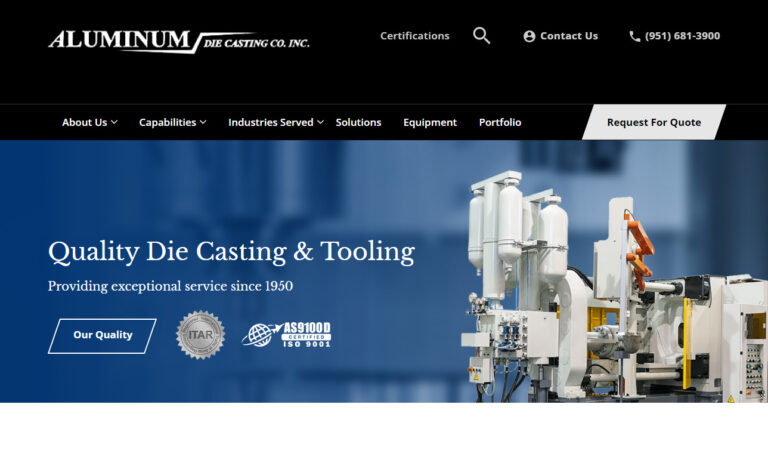Little Known Facts About Aluminum Castings Company.
Table of ContentsAluminum Castings Company Fundamentals ExplainedThe 20-Second Trick For Aluminum Castings CompanyAll About Aluminum Castings CompanyHow Aluminum Castings Company can Save You Time, Stress, and Money.Aluminum Castings Company Things To Know Before You Get ThisAluminum Castings Company for BeginnersSome Known Facts About Aluminum Castings Company.A Biased View of Aluminum Castings Company
There are two key kinds of die casting made use of in the aluminum spreading market: hot chamber pass away casting and chilly chamber die casting. The primary difference between these methods is just how the molten metal is delivered to the mold and mildew. In warm chamber pass away spreading, frequently used for lower melting factor metals, the melting pot is directly attached to the equipment, and a bettor forces the product through a gooseneck into the die tooth cavity.
Facts About Aluminum Castings Company Uncovered
In these approaches, the mold and mildew is purposefully damaged or damaged away in order to draw out the finished light weight aluminum spreading. Usual processes under the category of expendable mold casting consist of (investment spreading),,, and investment spreading. When producing custom-made light weight aluminum parts utilizing expendable molds, suppliers put molten light weight aluminum or light weight aluminum alloys right into the mold and mildew, which is after that damaged apart to release the solidified metal component.
The is one of the oldest and most utilized kinds of light weight aluminum casting. It includes condensing specialized foundry sand, typically enhanced with clay or material, around a specifically crafted recyclable pattern that identifies the shape and interior details of the completed aluminum product. The pattern system integrates risers and vents to take care of the circulation of molten steel and to stop casting flaws such as shrinkage porosity.
Fascination About Aluminum Castings Company

This mold is then preheated before Metal Foundry the putting of molten aluminum or aluminum alloy. As the metal fills the covering, it captures the complex information and fine surface area finish of the mold and mildew. Once cooled down, the ceramic is mechanically or chemically escaped, enabling the removal and separation of specific actors parts.
The Greatest Guide To Aluminum Castings Company
Permanent mold casting makes use of recyclable metal mold and mildews and is excellent for mass manufacturing with constant quality and less waste. Expendable mold spreading uses single-use mold and mildews, like sand or foam, offering layout versatility and lower tooling prices for models or brief runs. Pass away casting is best for creating high quantities of aluminum components that require limited tolerances, great details, and smooth surface areas.
The Toshiba Maker DC-J Series includes die casting machines suitable for aluminum. Recognized for their robust building and high injection efficiency, these equipments ensure effective and accurate spreading (Aluminum Castings Company).

While light weight aluminum can be made use of in its pure type, it is frequently alloyed with other metals to boost its buildings or the properties of the other metals. Light weight aluminum alloys are categorized into eight series, phoned number from one to eight.
The Buzz on Aluminum Castings Company
This alloying improves the stamina and firmness of light weight aluminum but lowers its ductility and corrosion resistance. The 3000 series alloys are largely alloyed with manganese.
The 4000 collection alloys are alloyed with silicon, which decreases the melting factor and boosts fluidness. This makes it a prominent option for casting, as it is easy to develop in its liquified state.
Top Guidelines Of Aluminum Castings Company
This series is identified as a high-strength alloy, particularly matched for sheet and plate applications because of its exceptional weldability. Its resistance to deterioration from acids and alkalis makes it excellent for usage in severe and hostile environments (Metal Foundry). The 6000 series alloys are alloyed with both magnesium and silicon, providing a balance of stamina, mechanical homes, and rust resistance
Handling the 6000 collection needs specialized and innovative devices, which can be intricate and pricey. However, this collection is understood for its excellent corrosion and oxidation resistance, in addition to its convenience of coating, treatment, and workability. The 7000 collection light weight aluminum alloys are the greatest and most resilient amongst aluminum types, with toughness similar to around two-thirds of industrial-grade A3 steel.
Aluminum Castings Company for Beginners
Zinc is the primary alloying aspect in the 7000 collection, improving the solidity of the aluminum, although zinc's firmness is similar to that of aluminum on the Mohs scale. The 8000 series light weight aluminum alloys are largely alloyed with tin, along with little amounts of copper and nickel (Core Making). While these alloys offer reduced stamina compared to other collection, they excel in machinability and use resistance
Aluminum cast heatsinks are electrically conductive, allowing them to be grounded effectively. They are typically cast with integrated functions that decrease the requirement for additional procedures, such as additional machining or setting up, resulting in additional price financial savings. Light weight aluminum spreading is regularly made use of to produce braces for both durable commercial devices and household appliances.
Not known Facts About Aluminum Castings Company
The single-piece construction of light weight aluminum braces enhances their toughness and longevity, lowering the probability of failure. If holes are needed, they can be included straight in the spreading mold, lessening the need for post-production finishing (https://filesharingtalk.com/members/625115-alumnmcstngs?tab=aboutme&simple=1). Suppliers have progressively adopted light weight aluminum casting for golf devices due to its toughness, stability, and flexibility in shaping